
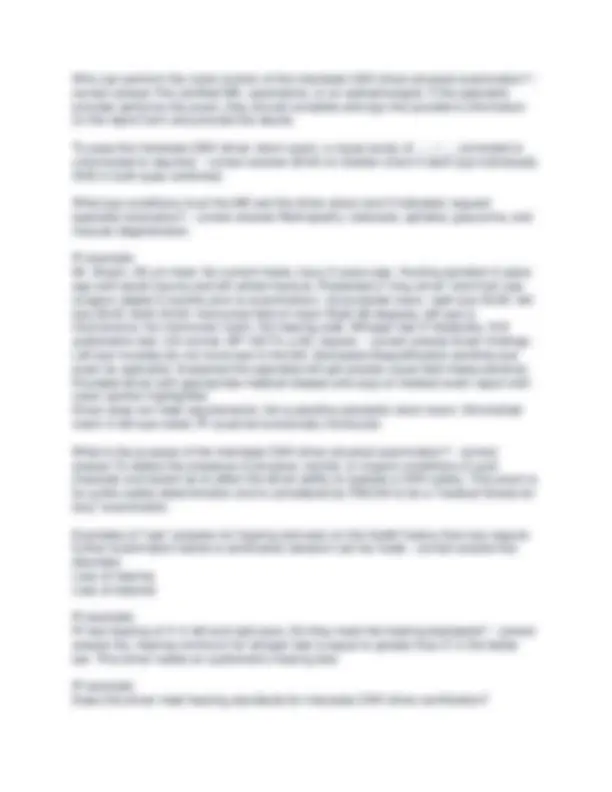
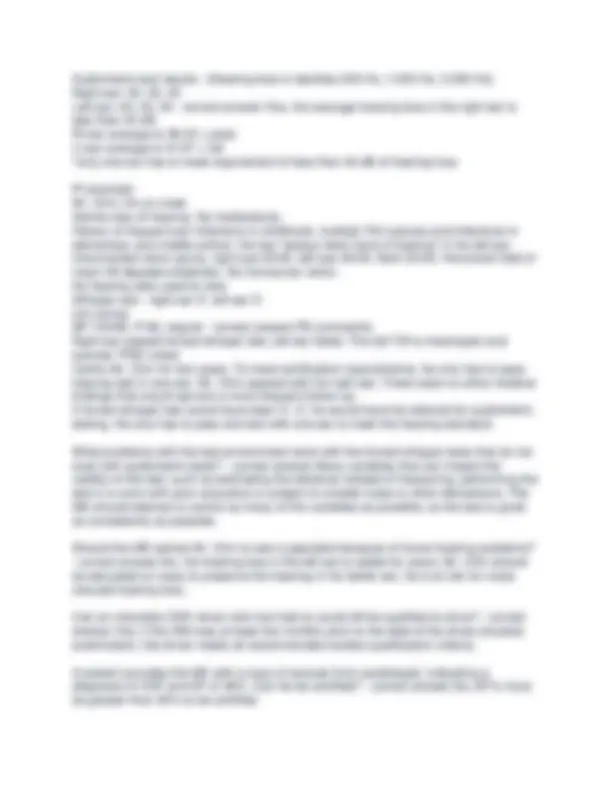
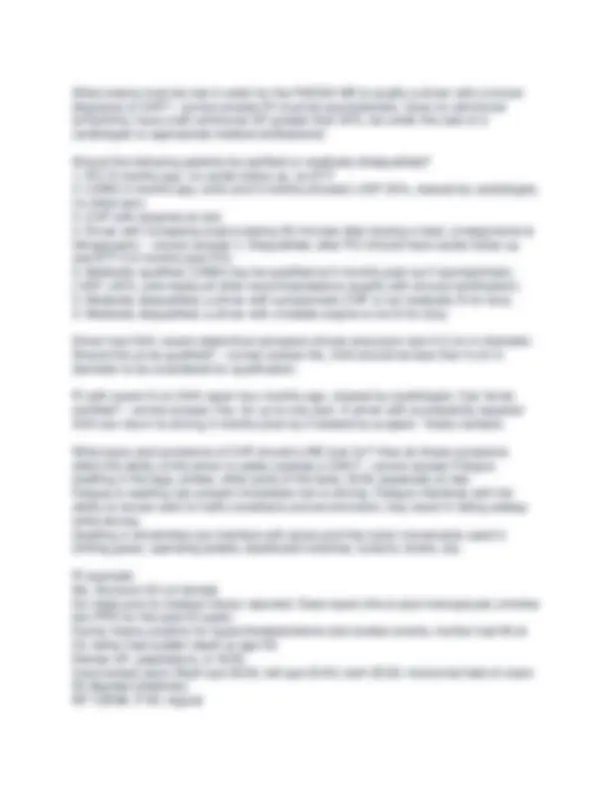
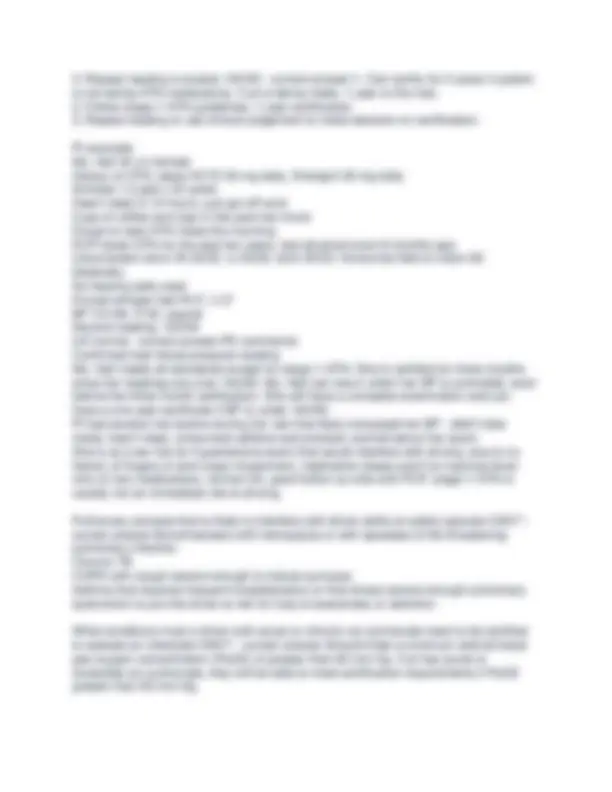
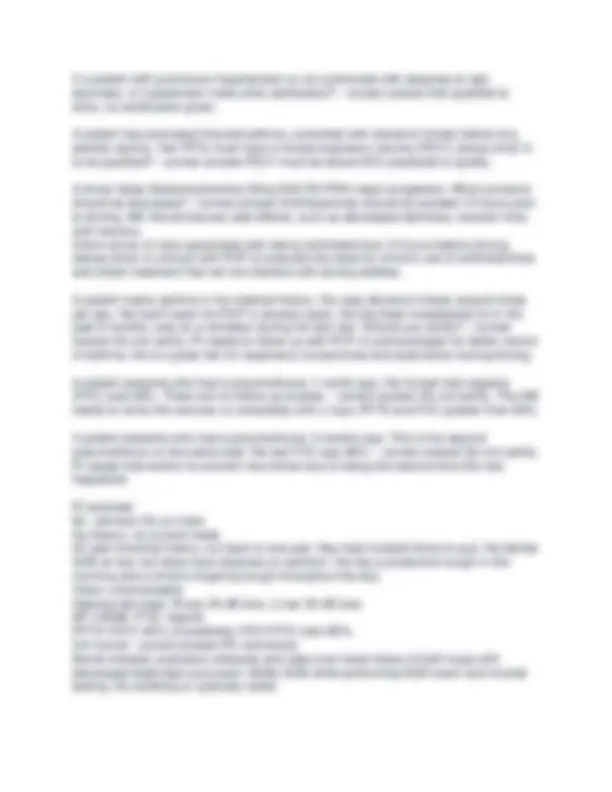
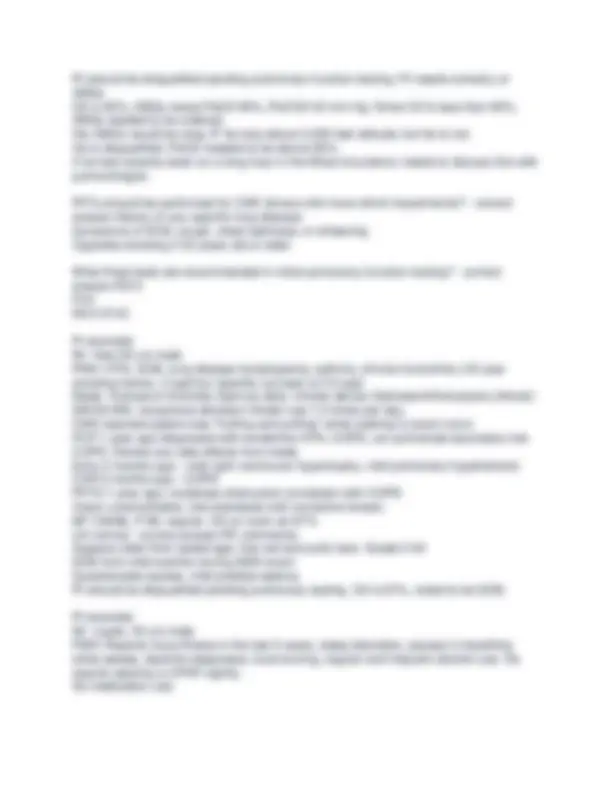
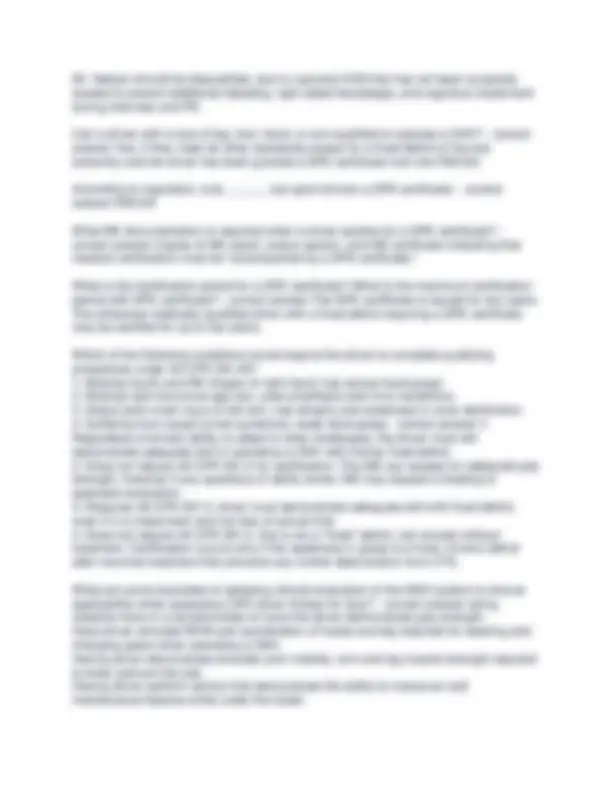
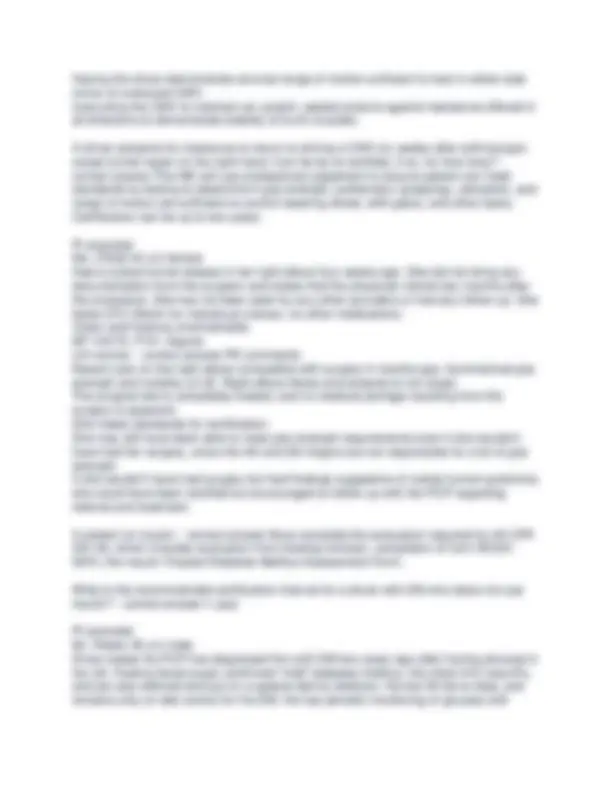
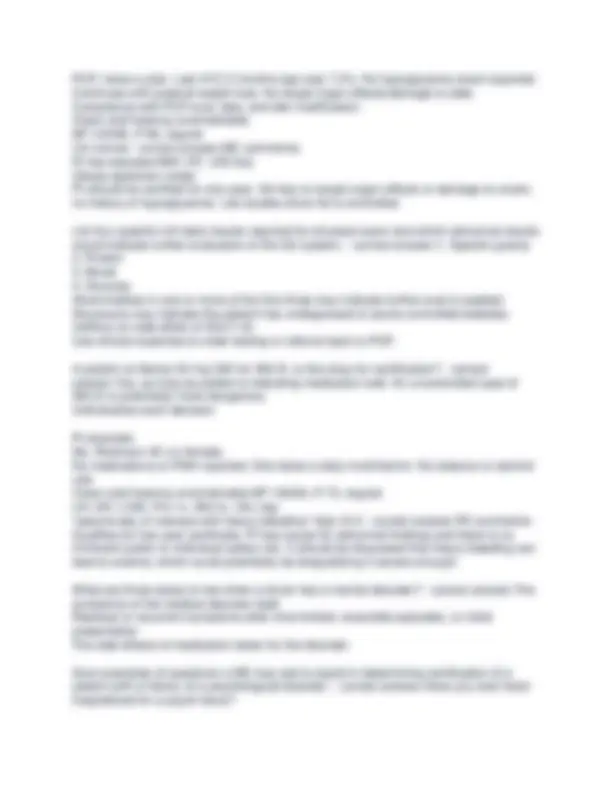
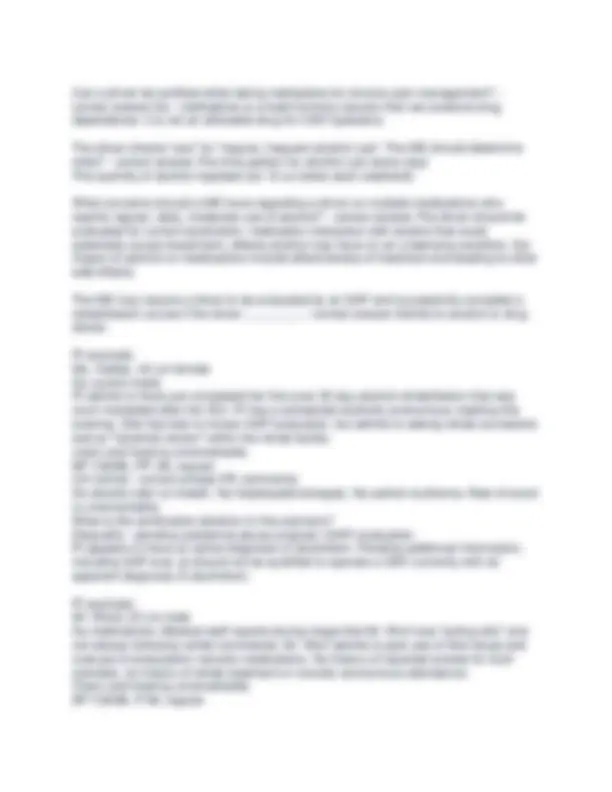
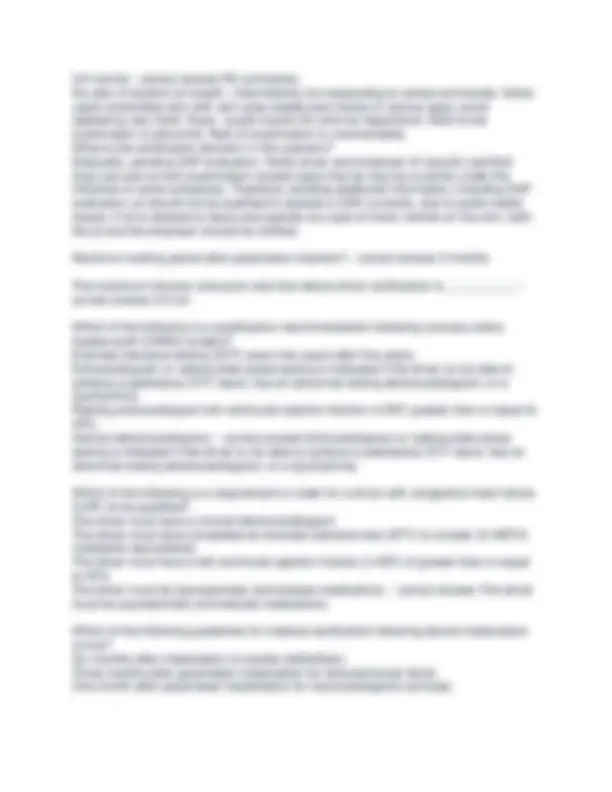
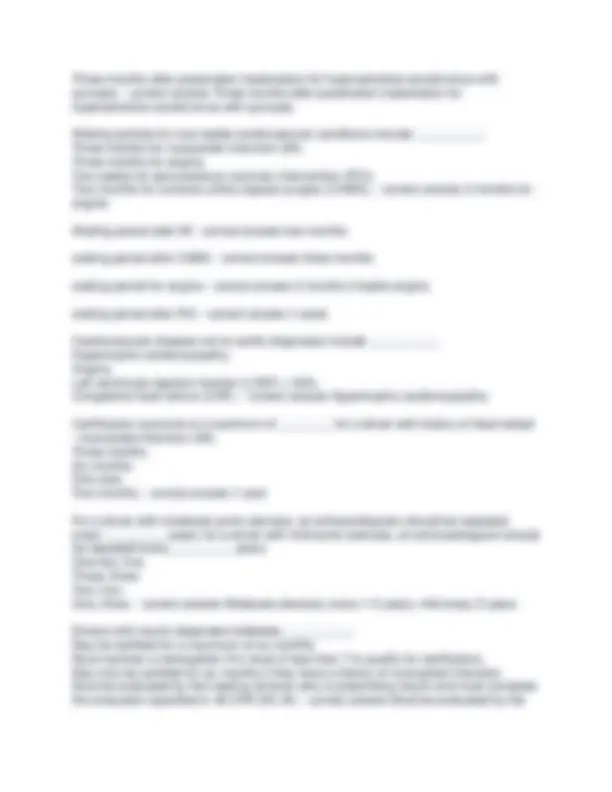
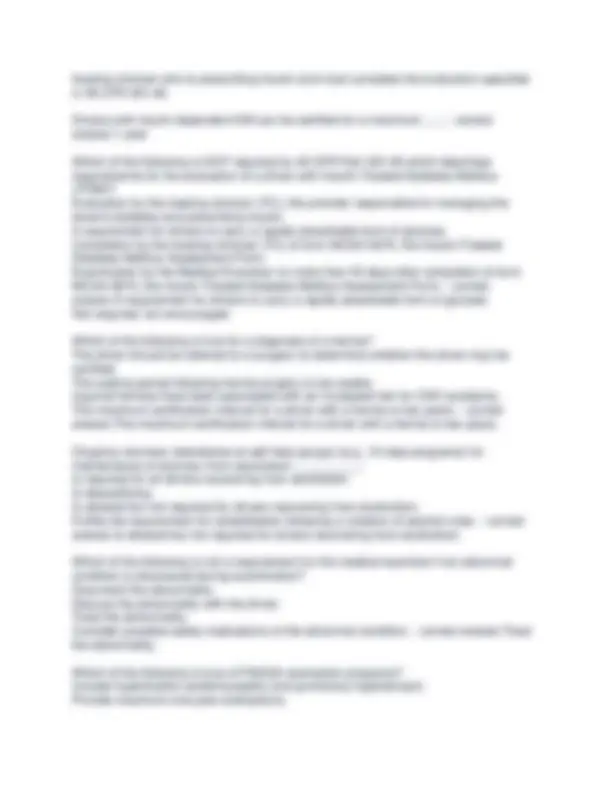
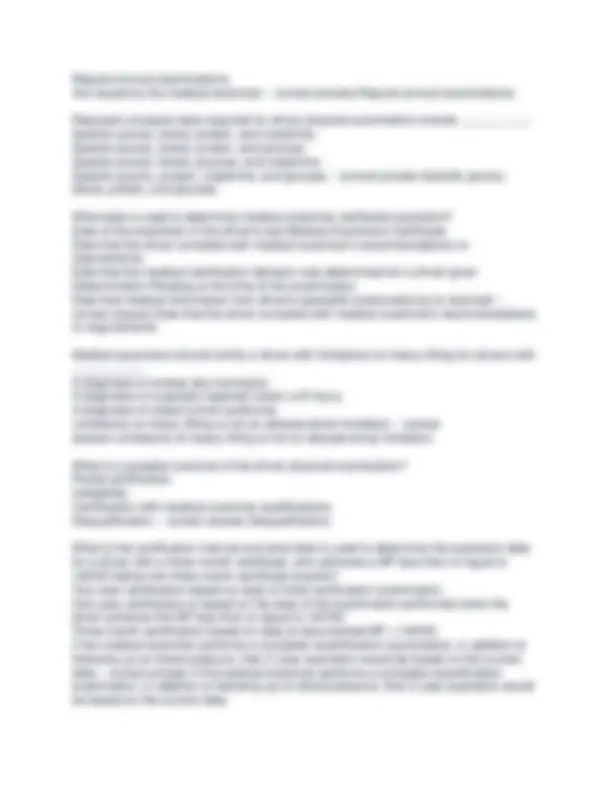
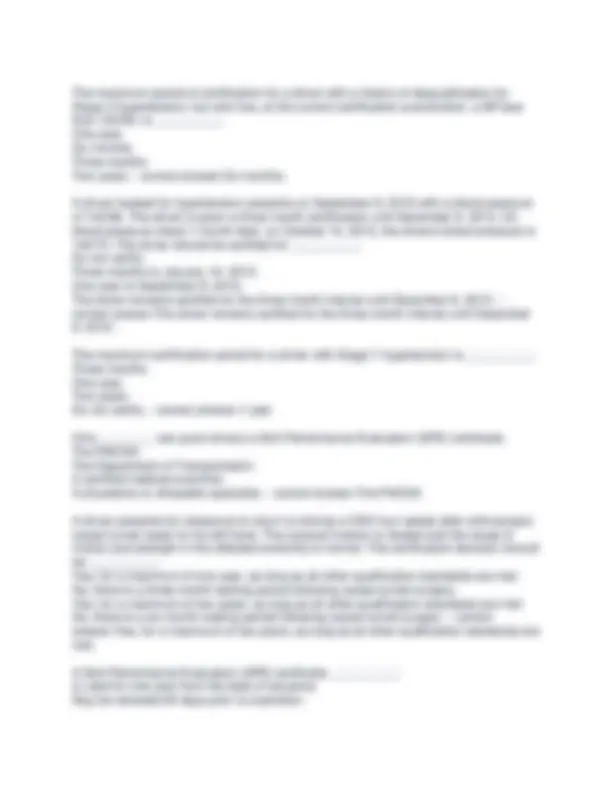
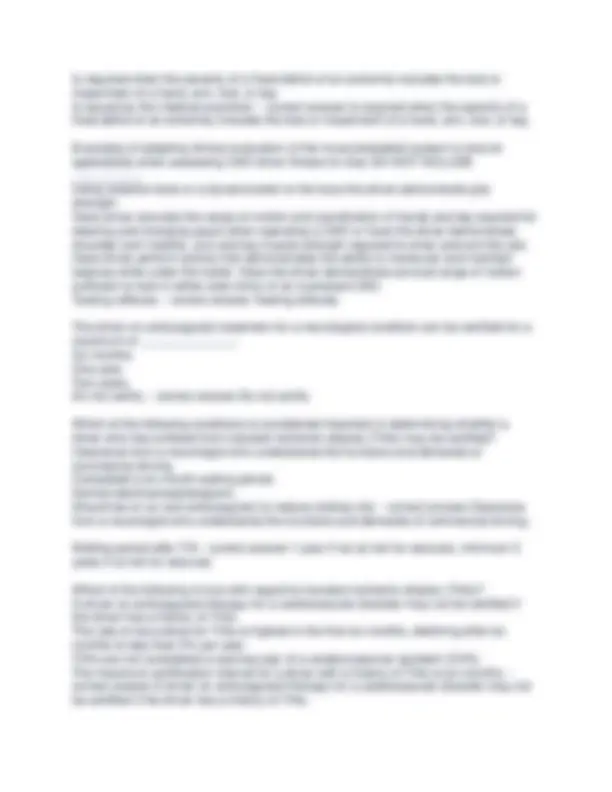
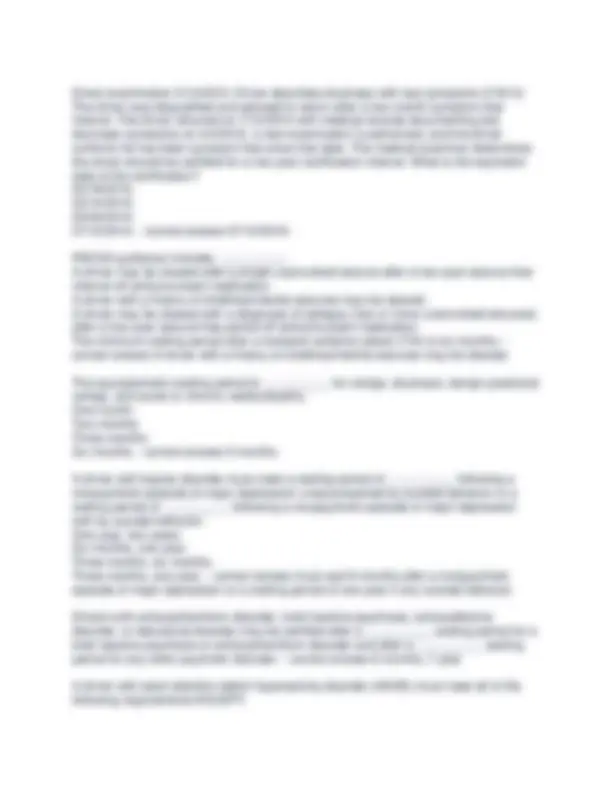
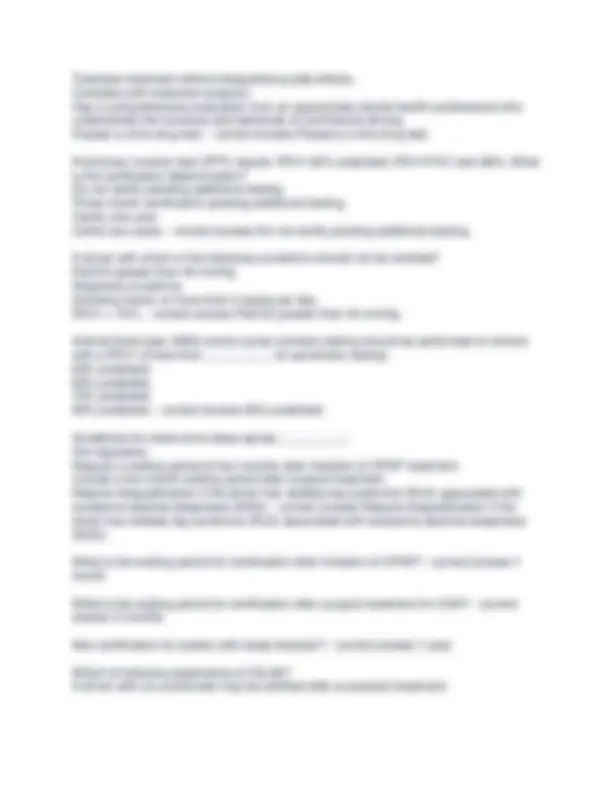
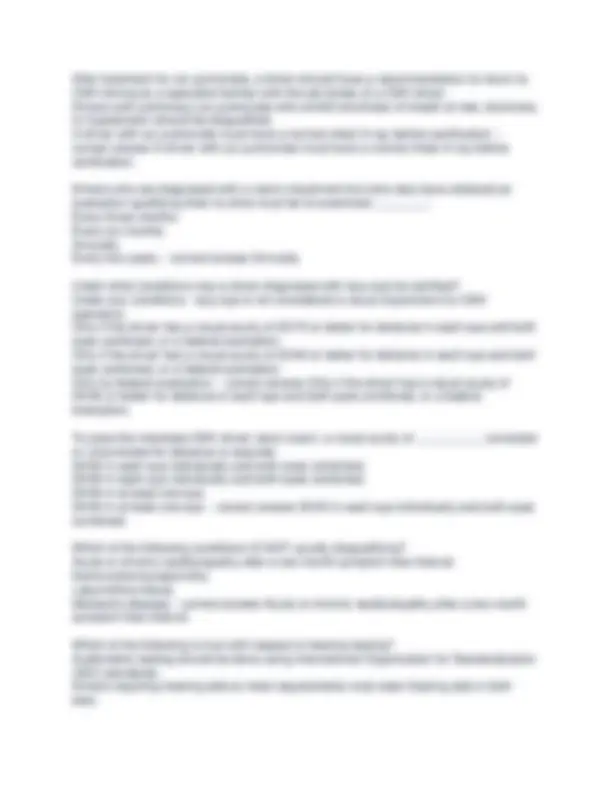



Study with the several resources on Docsity

Earn points by helping other students or get them with a premium plan


Prepare for your exams
Study with the several resources on Docsity

Earn points to download
Earn points by helping other students or get them with a premium plan
Community
Ask the community for help and clear up your study doubts
Discover the best universities in your country according to Docsity users
Free resources
Download our free guides on studying techniques, anxiety management strategies, and thesis advice from Docsity tutors
NRCME Exam With Real And Correct Questions And Answers 2024.
Typology: Exams
1 / 28

This page cannot be seen from the preview
Don't miss anything!





















What is the mission of FMCSA? - correct answer.FMCSA is focused on reducing crashes, injuries, and fatalities involving large trucks and buses. Who and what does the FMCSA regulate? - correct answer.Interstate commercial operation, including the driver, vehicle, motor carrier, and the transport of hazardous materials. Examples of CMV driver stress factors - correct answer.Interruption of normal sleep, exercising, eating pattern, and access to social support networks resulting in fatigue, obesity, and or/alienation of affection. Environment that may have excessive vibration, noise, and extremes in temperature and or/adverse road or traffic conditions that can interfere with driver ability to recognize a driving hazard, cause temporary or permanent physical damage to sensory perception or affect driver behavior. Increased potential for injury and fatalities should there be a crash when driver is responsible for passenger safety or hazardous cargo. What are the differences between the medical standards and medical guidelines? - correct answer.Regulations are law and are mandatory. The ME must use standards to determine interstate CMV driver medical fitness for duty. Medical guidelines are not regulatory and the ME may choose not to follow the medical guidance. In which regulations are the driver physical qualification standards and Medical Examiners cited? - correct answer.Driver physical qualification standards are found in 49 CFR 391.41. ME responsibilities are found in 49 CFR 391. What objective tests and measurements are required as part of the driver physical examination? - correct answer.Height & weight Vision Hearing BP & pulse Urinalysis (spec gravity, protein, blood, glucose) What are the possible outcomes of the driver physical examination? - correct answer.Certification
Disqualification Determination pending What date is used to determine medical examiners certificate expiration? - correct answer.The date of the exam is used as the basis for certificate expiration, except when determination pending is chosen. When determination pending is chosen, if the driver returns with the necessary information prior to the expiration of the driver's current certificate and the driver is qualified based on that information provided, the date used for the basis of the certification timeframe is the date the driver returned with the necessary information. What is the ME certificate expiration date for the following drivers? A - Exam 4/16/2011, meets standards in 49 CFR 391.41, qualifies for 2 year certificate. B - Exam 4/16/2011, meets standards, but periodic monitoring required due to HTN, qualifies for 1 year certificate. C - Exam 4/16/2011, determination pending due to not having results of post-CABG stress test, pt returns and provides that info on 4/25/2011, driver is qualified for 1 year. D - Exam 4/16/2011, disqualified due to benign position vertigo on 3/15/2011, returned to ME for certification examination on 5/20/11. He has been asymptomatic since 3/11/2011. Qualified for two years. - correct answer.A: 4/16/ B: 4/16/ C: 4/25/ D: 5/20/ Patient example: Karen, recertification exam 42 y/o female No health history, no medications. Vision acuity: right 20/20, left 20/30. Both 20/20. Horizontal field of vision Rt 80 degrees, Lt 80 degrees. Not corrected vision. No monocular vision. No hearing aids, Whisper test 5' bilaterally. N/A audiometric testing UA: spec grav 1.020, protein 1+, blood 4+, glucose neg. Hgb 12. BP 134/88, P 80, regular. PE: on 4th day of menses with heavy bleeding. Advised to consult PCP or GYN for eval of excessive bleeding that could lead to anemia, leading to fatigue that would affect her driving. - correct answer.Two year certification - no disqualifying health history or PE abnormalities. Ask about medication use, including OTC medications. ME obtained hemoglobin testing based on PE findings. (not required) The ME should correctly note the body system in which there was an abnormal finding. The note reflects inquiry as to the affect on driving ability and is also supported by Hgb test results. ME also documented medical follow up advice.
Audiometric test results - [Hearing loss in decibles 500 Hz, 1,000 Hz, 2,000 Hz] Right ear: 30, 45, 40 Left ear: 45, 45, 35 - correct answer.Yes, the average hearing loss in the right ear is less than 40 dB. Rt ear average is 38.33 = pass Lt ear average is 41.67 = fail *only one ear has to meet requirement of less than 40 dB of hearing loss Pt example: Mr. Chin, 54 y/o male Admits loss of hearing. No medications. History of frequent ear infections in childhood, multiple TM ruptures and infections in elementary and middle school. He has "always been hard of hearing" in his left ear. Uncorrected vision acuity, right eye 20/30. left eye 20/30. Both 20/30. Horizontal field of vision 90 degrees bilaterally. No monocular vision. No hearing aids used for test. Whisper test - right ear 5', left ear 3'. UA normal BP 134/80, P 86, regular - correct answer.PE comments: Right ear passed forced whisper test, left ear failed. The left TM is misshapen and scarred. PND noted. Certify Mr. Chin for two years. To meet certification requirements, he only has to pass hearing test in one ear. Mr. Chin passed with his right ear. There were no other medical findings that would warrant a more frequent follow-up. If forced whisper test would have been 4', 3', he would have be referred for audiometric testing. He only has to pass one test with one ear to meet the hearing standard. What problems with the test environment exist with the forced whisper tests that do not exist with audiometric tests? - correct answer.Many variables that can impact the validity of the test, such as estimating the distance instead of measuring, performing the test in a room with poor acoustics or subject to outside noise or other distractions. The ME should attempt to control as many of the variables as possible, so the test is given as consistently as possible. Should the ME advise Mr. Chin to see a specialist because of future hearing problems?
What criteria must be met in order for the FMCSA ME to qualify a driver with a known diagnosis of CHF? - correct answer.Pt must be asymptomatic, have no ventricular arrhythmia, have a left ventricular EF greater than 40%, be under the care of a cardiologist or appropriate medical professional. Should the following patients be certified or medically disdqualified?
Post CABG guidance for certification requirements - correct answer.Cleared by cardiologist Waited 3 months since procedure Asymptomatic Has no side effects that would interfere with driving Tolerates medications LVEF greater than 40% After 5 years, ETT due to accelerated graft closures Renewed yearly EKG after surgery, at clinic or in hospital Pt example: Mr. Gray, 45 y/o male. Health history includes heart disease or heart attack. Takes ASA daily. Currently sees cardiologist for single episode of CP that was 2 weeks ago while roofing his home. CP lasted 30 minutes, gradually resolved without treatment, located in the left pectoral area, not radiating, aggravated by movement of the left arm. Mild residual soreness present for 24 hours, "felt like a charley horse". Consulted PCP who referred him to cardio. Cardio report: ASA started day after event, normal EKG, scheduled labs and ETT in two weeks, no additional meds prescribed, no activity restrictions, no recurrence of chest pain, continue to run 2 miles three times a week, no previous history of CV disease, nonsmoker, no history of hyperlipidemia, father had MI at age 69. Uncorrected vision right eye 20/25, left eye 20/25, both eyes 20/25. Horizontal field of vision 90 bilaterally. No monocular vision. N - correct answer.Exam comments: Certified for three months, pending labs and stress test result follow-up. The etiology of chest pain has not been proven or disproven to be CHD. What is the maximum certification period for an interstate CMV driver with stage 1 HTN? - correct answer.1 year What is the proper determination for an interstate CMV driver with HTN, who presents with confirmed BP of 182/112? if he comes back and it is controlled below 140/90, what is the certification period? - correct answer.Disqualified until BP is controlled below 140/90. Can have six month certificate if he comes back with controlled BP. What is the BP range for stage 1 HTN? - correct answer.140/90-159/ 140 - 159 over 90- 99 A BP of 140/90 should be confirmed with a second reading during the exam. What certification would you give if:
Pt should be disqualified pending pulmonary function testing. Pt needs oximetry or ABGs. O2 is 90%, ABGs reveal PaO2 60%, PaCO2 42 mm Hg. Since O2 is less than 92%, ABGs needed to be ordered. His ABG's would be okay IF he was above 5,000 feet altitude, but he is not. He is disqualified. PaO2 needed to be above 65%. If he had recently been on a long-haul in the West mountains, needs to discuss this with pulmonologist. PFTs should be performed for CMV drivers who have which impairments? - correct answer.History of any specific lung disease Symptoms of SOB, cough, chest tightness, or wheezing Cigarette smoking if 35 years old or older What three tests are recommended in initial pulmonary function testing? - correct answer.FEV FVC FEV1/FVC Pt example: Mr. Katz 65 y/o male PMH: HTN, SOB, lung disease (emphysema, asthma, chronic bronchitis.) 50 year smoking history, 2 ppd but recently cut back to 0.5 ppd. Meds: Tiotropium bromide (Spiriva) daily, inhaler device Salmeterol/fluticasone (Advair) 500/50 BID, occasional albuterol inhaler use 1-2 times per day. CMA reported patient was "huffing and puffing" while walking to exam room. PCP 1 year ago diagnosed with borderline HTN, COPD, cor pulmonale secondary two COPD. Denies any side effects from meds. Echo 2 months ago - mild right ventricular hypertrophy, mild pulmonary hypertension CXR 6 months ago - COPD PFTS 1 year ago, moderate obstruction consistent with COPD Vision unremarkable, met standards with corrective lenses. BP 138/86, P 88, regular. O2 on room air 87% UA normal - correct answer.PE comments: Appears older than stated age, has red and puffy face. Grade 2 S SOB from mild exertion during MSK exam Questionable ascites, mild pretibial edema. Pt should be disqualified pending pulmonary testing. O2 is 87%, noted to be SOB. Pt example: Mr. Lopez, 50 y/o male PMH: Reports injury/illness in the last 5 years, sleep disorders, pauses in breathing while asleep, daytime sleepiness, loud snoring, regular and frequent alcohol use. He reports wearing a CPAP nightly. No medication use.
Pneumonia two years ago, was diagnosed with OSA at the same time. CPAP works well, he wakes feeling rested. No PCP visit in 2 years. Drinks 2 beers during weekends when he's off work. Vision unremarkable Passed whisper test BP 138/88, P 84, regular UA: trace protein, otherwise normal. - correct answer.PE comments: Obese, medium-sized ventral hernia that is easily reducible. Mr. Lopez's CPAP has a recorder which indicated consistent use. He is qualified for one year. Pt needs to schedule follow-up with PCP or pulmonologist who is managing CPAP. He has no indication of risk of sudden incapacitation. Pt with sleep disorder should be monitored. What neurological condition is medically disqualifying? - correct answer.Epilepsy What episodic neurological conditions are disqualifying? - correct answer.Extreme headaches - migraine, cluster headaches, neuralgia that could affect ability to remain cognizant of driving conditions and tasks Vertigo Diagnosed epilepsy treated with anticonvulsant meds Narcolepsy Sleep apnea that is untreated Idiopathic CNS hypersomnolence and Primary Alveolar Hyperventilation Syndrome Restless legs associated with disorder of excess somnolence (RLS-DOES) syndrome. Examples of neurological conditions that are considered medically unqualified according to medical guidance? - correct answer.Febrile seizures Dementia (severe) Dementia (metabolic) TIA within 1 year TIA greater than 1 year ago What is the meaning of "no functional residual" when in reference to TIAs? - correct answer.Lack of impairment. The individual has no residual neurological deficit, as determined by a neurologist, has no impairment that is not in any way affecting the functional ability of the driver. What are the recommended criteria that must be met after a patient has a TIA? - correct answer.Pt is automatically disqualified for 1 year after event. They are at a high rate of recurrent during the first year after the TIA. This is warning sign of a potentially severe stroke. After the 1 year is up, certification depends on interval history, general health, and neuro clearance. Pt example: Ms. Miller, 44 y/o female Reports muscular disease
Mr. Nelson should be disqualified, due to ruptured AVM that has not been surgically treated to prevent additional bleeding, right-sided hemiplegia, and cognitive impairment during interview and PE. Can a driver with a loss of leg, foot, hand, or arm qualified to operate a CMV? - correct answer.Yes, if they meet all other standards except for a fixed deficit of the lost extremity and the driver has been granted a SPE certificate from the FMCSA. According to regulation, only ______ can grant drivers a SPE certificate. - correct answer.FMCSA What ME documentation is required when a driver applies for a SPE certificate? - correct answer.Copies of ME report, status section, and ME certificate indicating that medical certification must be "accompanied by a SPE certificate." What is the certification period for a SPE certificate? What is the maximum certification period with SPE certificate? - correct answer.The SPE certificate is issued for two years. The otherwise medically qualified driver with a fixed deficit requiring a SPE certificate may be certified for up to two years. Which of the following conditions would require the driver to complete qualifying procedures under 49 CFR 391.49?
Having the driver demonstrate cervical range of motion sufficient to look in either side mirror of oversized CMV. Instructing the CMV to maintain an upright, seated posture against resistance offered in all directions to demonstrate stability of trunk muscles. A driver presents for clearance to return to driving a CMV six weeks after arthroscopic carpal tunnel repair on his right hand. Can he be re-certified, if so, for how long? - correct answer.The ME will use professional judgement to ensure patient can meet standards by testing to determine if grip strength, prehension (grasping), sensation, and range of motion are sufficient to control steering wheel, shift gears, and other tasks. Certification can be up to two years. Pt example: Ms. O'Dell 42 y/o female Had a cubital tunnel release in her right elbow four weeks ago. She did not bring any documentation from the surgeon and states that the physician retired two months after the procedure. She has not been seen by any other providers or had any follow-up. She takes OTC Motrin for menstrual cramps, no other medications. Vision and hearing unremarkable. BP 122/72, P 67, regular. UA normal. - correct answer.PE comments: Recent scar on the right elbow compatible with surgery 4 months ago. Symmetrical grip strength and mobility of UE. Right elbow flexes and extends to full range. The surgical site is completely healed, and no residual damage resulting from the surgery is apparent. She meets standards for certification. She may still have been able to meet grip strength requirements even if she wouldn't have had her surgery, since the 4th and 5th fingers are not responsible for a lot of grip strength. If she wouldn't have had surgery but had findings suggestive of cubital tunnel syndrome, she could have been certified but encouraged to follow up with her PCP regarding referral and treatment. A patient on insulin: - correct answer.Must complete the evaluation required by 49 CFR 391.46, which includes evaluation from treating clinician, completion of form MCSA- 5870, the Insulin-Treated Diabetes Mellitus Assessment Form. What is the recommended certification interval for a driver with DM who does not use insulin? - correct answer.1 year Pt example: Mr. Peters 55 y/o male Driver states his PCP has diagnosed him with DM two years ago after having glucose in his UA. Fasting blood sugar confirmed "mild" diabetes mellitus. His initial A1C was 8%, and pts was referred and put on a special diet by dietician. He lost 50 lbs to date, and remains only on diet control for his DM. He has periodic monitoring of glucose with
Have you ever thought of hurting yourself? Have you ever considered suicide? Have you attempted to commit suicide through crashing a vehicle? Do you often fight? Do you think or have you ever thought of hurting or killing other people? Do you experience problems concentrating or remembering things? Do you hear or have you heard voices that other people do not hear or have not heard? Do you see or have you seen things that other people do not see or have not seen? Do you take any medications for a nervous disorder? What behaviors should a ME look for in a patient with a psychological disorder? - correct answer.Any suspicious, evasive, threatening, or hostile behaviors Signs of being easily distracted Signs of flat affect or lack of emotional response Displays of unusual or bizarre ideas, auditory or visual hallucinations, dishonesty, or a tendency to omit important information Can a driver who is taking Amitriptyline be certified? - correct answer.Drivers taking Amitriptyline should not be certified, however the ME should evaluate the patient and in consultation with appropriate mental health professional may determine if a driver is stable and has no side effects that would interfere with driving. Driver should document rationale and medical evidence that supports the certification decision. A driver presents with history of depression taking an SSRI, but appears depressed. - correct answer.The ME should have the patient referred to the appropriate medical health professional who would treat and monitor the driver. Before certification, the driver would have to complete a symptom-free waiting period and have an effective, well-tolerated treatment plan, with no side effects that impair the ability of the driver to operate a CMV safely. Give examples of reported CMV driver symptoms and findings related to mental health that may lead a ME to decide not to certify a driver. - correct answer.Emotional or adjustment problems - have been linked a changes in memory, reasoning, attention, and judgment (ex: severe bereavement) Functional disorders - may cause drowsiness, dizziness, confusion, weakness, and paralysis, which may lead to poor coordination , inattention, loss of functional control, and increased risk of crashes while driving. Physical fatigue, headache, impaired coordination, recurring physical ailment, chronic "nagging pain" (ex: severe cluster headaches) to a degree that CMV driving is inadvisable. Disorders of periodic incapacitation may warrant disqualification (ex: schizophrenia, bipolar mood disorder) Pt example: Mr. Smith 43 y/o male Pt takes Paxil 40 mg once daily
Mr. Smith provided a letter fro his psychiatrist that is dated four months ago, history of suicide attempt 6 months before this report (10 months prior to this current examination), suicide attempt followed the drowning death of his two year old son in a swimming pool accident, psychiatrist clearance to return to work and normal activities. Mr. Smith admits to seeking professional help because of his feelings of excessive guilt over the accident, he denies current SI or HI or hallucinations. He denies any adverse side effects. from the Paxil. He admits to drinking several cups of coffee per day, drinking 1-2 beers on weekends only, denies and drug use. Pt's family history includes a father with depression and died of AMI at 83 years old. His mother has history of depression and remains functional on medication. Vision and hearing unremarkable. BP 132 - correct answer.PE comments: Although he related being stressed, his affect is normal, his appearance is appropriate, and personal hygiene is good. Disqualify until the patient meets the required waiting period after a suicide attempt, then re-examine driver. Driver should be symptom free for one year after a suicide attempt, a severe depression, or manic episode. Pt example: Mr. Taylor 22 y/o male No medications Pt denies any medical history, admits to smoking two ppd and drinks 10 "Jolt" colas per day. He presents with poor eye contact and flat affect. Vision and hearing unremarkable. BP 120/68 P: 96, regular UA normal - correct answer.PE comments: His mouth is dry Tremor at rest with left eyelid tic Pupils sluggish, extraocular eye movements lack convergence. Refused to pull down his pants for hernia exam, becomes agitated and stated that he "can't undress" Mild ataxia, Rhomberg positive (closing eyes caused unbalance) There is significant concern about psychological pathology. Mr. Taylor declined to participate in MMSE, saying, "these questions are dumb." Pt should be disqualified pending mental health and neurological examinations. The minimal PE was not able to be completed, thereby resulting in disqualification. The patient is uncooperative, has inconsistent responses, has flat affect and is easily provoked, the ME is unable to perform a reliable history and PE. Is testing for controlled substances part of the requirement of the CMV driver physical examination? - correct answer.No, however the ME may require additional testing if they feel it is necessary. What is the Advisory Criteria for the Drug Use definition of "habit forming"? - correct answer.The term habit-forming is intended to include any drug or medication generally recognized as capable of becoming habitual, and impair the user's ability to operate a CMV.
UA normal - correct answer.PE comments: No odor of alcohol on breath.. Intermittently not responding to verbal commands. Distal upper extremities skin with vein area needle tract marks of various ages, some appearing very fresh. Eyes - pupils myotic OU and not responsive. Heel-to-toe examination is abnormal. Rest of examination is unremarkable. What is the certification decision in this scenario? Disqualify, pending SAP evaluation. Notify driver and employer of narcotic use/illicit drug use and current examination reveals signs that he may be currently under the influence of some substance. Therefore, pending additional information, including SAP evaluation, pt should not be qualified to operate a CMV currently, due to public safety issues, if he is allowed to leave and operate any type of motor vehicle on his own, both the pt and the employer should be notified. Maximum waiting period after pacemaker insertion? - correct answer.3 months The maximum thoracic aneurysm size that allows driver certification is __________. - correct answer.3.5 cm Which of the following is a qualification recommendation following coronary artery bypass graft (CABG) surgery? Exercise tolerance testing (ETT) every two years after five years. Echocardiogram or radionuclide stress testing is indicated if the driver is not able to achieve a satisfactory ETT result, has an abnormal resting electrocardiogram, or a dysrhythmia. Resting echocardiogram left ventricular ejection fraction (LVEF) greater than or equal to 45%. Normal electrocardiogram. - correct answer.Echocardiogram or radionuclide stress testing is indicated if the driver is not able to achieve a satisfactory ETT result, has an abnormal resting electrocardiogram, or a dysrhythmia. Which of the following is a requirement in order for a driver with congestive heart failure (CHF) to be qualified? The driver must have a normal electrocardiogram. The driver must have completed an exercise tolerance test (ETT) to at least 10 METS. (metabolic equivalents). The driver must have a left ventricular ejection fraction (LVEF) of greater than or equal to 45%. The driver must be asymptomatic and tolerate medications. - correct answer.The driver must be asymptomatic and tolerate medications. Which of the following guidelines for medical certification following device implantation is true? Six months after implantation of cardiac defibrillator. Three months after pacemaker implantation for atrioventricular block. One month after pacemaker implantation for neurocardiogenic syncope.
Three months after pacemaker implantation for hypersensitive carotid sinus with syncope. - correct answer.Three months after pacemaker implantation for hypersensitive carotid sinus with syncope. Waiting periods for now stable cardiovascular conditions include __________. Three months for myocardial infarction (MI). Three months for angina. Two weeks for percutaneous coronary intervention (PCI). Two months for coronary artery bypass surgery (CABG). - correct answer.3 months for angina Waiting period after MI - correct answer.two months waiting period after CABG - correct answer.three months waiting period for angina - correct answer.3 months if stable angina waiting period after PCI - correct answer.1 week Cardiovascular disease not-to-certify diagnoses include __________. Hypertrophic cardiomyopathy. Angina. Left ventricular ejection fraction (LVEF) < 50%. Congestive heart failure (CHF). - correct answer.Hypertrophic cardiomyopathy. Certification outcome is a maximum of ________ for a driver with history of heart attack